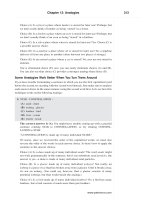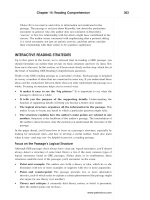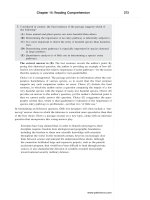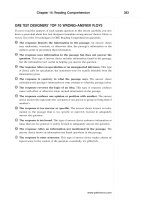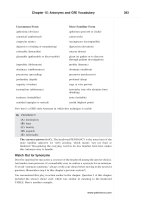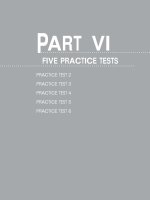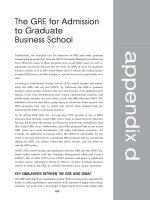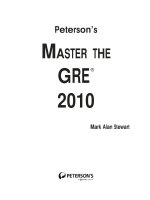Master the Gre 2010 - Part 40
Bạn đang xem bản rút gọn của tài liệu. Xem và tải ngay bản đầy đủ của tài liệu tại đây (51.77 KB, 10 trang )
7. Considered in context, the final sentence of the passage suggests which of
the following?
(A) Some animal and plant species are more harmful than others.
(B) Determining the importance of an entry pathway is inherently subjective.
(C) It is more important to detect the entry of harmful species than harmless
ones.
(D) Determining entry pathways is especially important for species detected
in large numbers.
(E) Quantitative analysis is of little use in determining a species’ entry
pathways.
The correct answer is (B). The last sentence reveals the author’s point: By
posing this rhetorical question, the author is providing an example of how dif-
ficult it is to determine the relative importance of entry pathways—for the reason
that the analysis is somewhat subjective (not quantifiable).
Choice (A) is unsupported. The passage provides no information about the com-
parative harmfulness of various species, so to assert that the final sentence
supports any such comparison makes no sense. Choice (C) distorts the final
sentence, in which the author raises a question comparing the impact of a few
very harmful species with the impact of many less harmful species. Choice (D)
provides an answer to the author’s question, yet the author’s rhetorical point is
that we cannot easily answer this question. Choice (E) exaggerates the para-
graph’s central idea, which is that quantitative evaluation of the importance of
species entry pathways is problematic—not that it is “of little use.”
In formulating an Inference question, GRE test designers will often include a “run-
ner-up” answer choice in which the inference is somewhat more speculative than that
of the best choice. Here’s a passage excerpt on a new topic, along with an inference
question that incorporates this wrong-answer ploy.
Scientists have long claimed that, in order to flourish and progress, their
discipline requires freedom from ideological and geographic boundaries,
including the freedom to share new scientific knowledge with scientists
throughout the world. In the twentieth century, however, increasingly close
links between science and national life undermined these ideals. Although
the connection facilitated large and expensive projects, such as the particle
accelerator program, that would have been difficult to fund through private
sources, it also channeled the direction of scientific research increasingly
toward national security (military defense).
Chapter 14: Reading Comprehension 373
.................................................................
..............................................................................................
www.petersons.com
8. In the passage, the author infers that
(A) expensive research projects such as the particle accelerator program
apply technology that can also be applied toward projects relating to
national security
(B) scientific knowledge had become so closely linked with national security
that it could no longer be communicated to scientific colleagues without
restriction
(C) without free access to new scientific knowledge, scientists in different
countries are less able to communicate with one another
(D) governments should de-emphasize scientific projects related to military
defense and emphasize instead research that can be shared freely within
the international scientific community
(E) government funding of scientific research undermines the ideal of
scientific freedom to a greater extent than private funding.
The correct answer is (B). The first two sentences establish that the link
between science and national life undermined scientists’ freedom to communicate
with other scientists. The next sentence points to the channeling of scientific
research toward protecting national security as a manifestation of that link.
Notice the almost unavoidable inference here—that national security concerns
were part of the “national life” that took precedence over scientific freedoms.
Choice (E) is a “runner-up” choice. You can argue from the information provided
in the first paragraph that government-funded research is more likely than
privately funded research to relate to matters affecting the national security (i.e.,
military defense). However, this inference is hardly as unavoidable as the one
that choice (B) provides. To compete with choice (B), the inference would need
additional supporting evidence. Choice (A) is unsupported. The author implies no
connection between the particle accelerator program and national security.
Choice (C) is nonsensical. Ready access to new scientific knowledge would require
ready communication among scientists, not the other way around. Choice (D) is
unsupported. The author neither states nor suggests which areas of scientific
research should be emphasized.
Restatement Questions
In handling a restatement question, your job is to understand a specific idea the
author is conveying in the passage. These questions are different from simple recall
questions in that you won’t find the answer explicitly in the text. And it’s this feature
that makes them more difficult. The question itself will look something like one of the
following:
“Which of the following statements about _______ is most strongly supported
by the passage’s information?”
“With which of the following statements about _______ would the author
most likely agree?”
“Which of the following best characterizes _______ as viewed by _______ ?”
PART V: Verbal Reasoning374
.................................................................
..............................................................................................
ALERT!
Don’t panic when you
encounter lengthy questions or
answer choices. Although
more reading usually makes
for a tougher question, this is
not always the case.
www.petersons.com
Returning to our passage about species migration, here’s a brief excerpt, along with a
restatement question based on it. Notice that the wrong-answer choices are designed
to confuse you by combining details from the excerpt that relate to the question, but
don’t “add up.”
The arrival of a nonindigenous plant or animal species in a new location
may be either intentional or unintentional. Rates of species movement
driven by human transformations of natural environments or by human
mobility—through commerce or tourism—dwarf natural rates by
comparison. While geographic distributions of species naturally expand or
contract over tens to hundreds of years, species’ ranges rarely expand
thousands of miles or across physical barriers such as oceans or mountains.
9. Which of the following statements about species movement is best
supported by the passage?
(A) Species movement is affected more by habitat modifications than by
human mobility.
(B) Human-driven factors affect the rate at which species move more than
they affect the long-term amount of such movements.
(C) Natural expansions in the geographic distribution of species account for
less species movement than natural contractions do.
(D) Natural environments created by commerce, tourism, and travel con-
tribute significantly to species movement.
(E) Movement of a species within a continent depends largely upon the
geographic extent of human mobility within the continent.
The correct answer is (E). This choice restates the author’s point in the first
paragraph that “rates of species movement driven by human transformation of
the natural environment and by human mobility . . . dwarf natural rates by
comparison.” Choice (A) is the most tempting wrong-answer choice. Based on the
passage, habitat modifications and human mobility can both affect species
movement, as choice (A) implies. And the passage does make a comparison
involving human-driven species movement. However, the comparison made in the
passage is between natural species movement and human-driven movement, not
between human modification of habitats and human mobility. So choice (A)
confuses the details of the passage. Choice (B) is easier to eliminate because it is
completely unsupported by the passage, which makes no attempt to compare rate
(interpreted either as frequency or speed) of species movement to total amounts
of movement (distance). Choice (C) is also easier to eliminate than choice (A). It is
completely unsupported by the passage. The author makes no attempt to
compare natural expansions to natural contractions. Choice (D) is the easiest to
eliminate. You don’t even need to read the passage to recognize that choice (D) is
a nonsensical statement. Human mobility (commerce, tourism, and travel) do not
create “natural” environments. Human mobility itself, not the “natural envi-
ronment” created by it, contributes significantly to species movement.
Here’s a good example of how GRE test designers might boost the difficulty level of a
restatement question. As you tackle the question based on the following passage
excerpt, notice that most of the wrong-answer choices appear to respond to the
Chapter 14: Reading Comprehension 375
.................................................................
..............................................................................................
TIP
In Reading Comprehension
questions, some answer
choices won’t make good
sense. Don’t be fooled into
second-guessing yourself just
because you don’t
understand what a
nonsensical answer
choice means.
www.petersons.com
question because they describe an “ambiguous position.” What’s more, most of the
answer choices contain information that the passage supports. The use of these two
wrong-answer ploys makes this question tougher than average:
Scientists in the post–1917 Soviet Union occupied an ambiguous position.
While the government encouraged and generally supported scientific
research, it simultaneously thwarted the scientific community’s ideal:
freedom from geographic and political boundaries. A strong nationalistic
emphasis on science led at times to the dismissal of all non-Russian
scientific work as irrelevant to Soviet science. A 1973 article in
Literatunaya Gazeta, a Soviet publication, insisted: “World science is based
upon national schools, so the weakening of one or another national school
inevitably leads to stagnation in the development of world science.”
According to the Soviet regime, socialist science was to be consistent with,
and in fact grow out of, the Marxism-Leninism political ideology.
10. Based on the information in the passage, which of the following best
characterizes the “ambiguous position” in which Soviet scientists were
placed during the decades that followed 1917?
(A) The Soviet government demanded that their research result in
scientific progress, although funding was insufficient to accomplish
this goal.
(B) They were exhorted to strive toward scientific advancements, while at
the same time the freedoms necessary to make such advancements were
restricted.
(C) Although they were required to direct research entirely toward military
defense, most advancements in this field were being made by non-Soviet
scientists with whom the Soviet scientists were prohibited contact.
(D) They were encouraged to collaborate with Soviet colleagues but were
prohibited from any discourse with scientists from other countries.
(E) The Soviet government failed to identify areas of research that it
deemed most worthwhile, but punished those scientists with whose
work it was not satisfied.
The correct answer is (B). According to the passage, the ambiguous position of
Soviet scientists was that the Soviet government encouraged and generally sup-
ported scientific research, while at the same time it imposed significant restric-
tions upon its scientists.
Choice (C) is the easiest one to eliminate. It is wholly unsupported by the
passage, which neither states nor suggests either assertion it makes—which in
any case does not describe an ambiguous situation. Choice (A) is also unsup-
ported by the passage. The author neither states nor suggests that the Soviets
lacked sufficient funding. Although if true, choice (A) would indicate an
ambiguous position for scientists, that ambiguity is not the kind cited to in the
passage. Choice (E) is unsupported as well. Although some Soviet scientists were
indeed punished by the government, the author neither states nor implies that
the government failed to identify those areas of research that it deemed most
worthwhile. If true, choice (E) would indicate an ambiguous position for scien-
tists; but as with choice (A), the ambiguity described in choice (E) is not the sort
PART V: Verbal Reasoning376
.................................................................
..............................................................................................
NOTE
If a question quotes the
passage, the quote will be
highlighted in the passage to
help you locate it.
www.petersons.com
referred to in the passage. Choice (D) is the most tempting wrong-answer choice.
It’s a better choice than either choice (A) or (E) because the passage supports it,
at least implicitly. What’s more, if true, choice (D) would present an ambiguous
position for Soviet scientists. However, as with choices (A) and (E), the ambiguity
that choice (D) describes doesn’t reflect the nature of the ambiguity referred to in
the passage’s first sentence.
Purpose-of-Detail Questions
This type of question is actually a specific-type of inference question that asks you to
infer the author’s purpose in mentioning a specific idea. Look for a question stem like
one of these:
‘‘The author’s discussion of...ismost probably intended to illustrate...”
“The author mentions...to...”
As with inference questions, purpose-of-detail questions will sometimes include a
runner-up answer choice. Here’s the Soviet science excerpt again. This time it’s
followed by a typical purpose-of-detail question.
Scientists in the post–1917 Soviet Union occupied an ambiguous position.
While the government encouraged and generally supported scientific
research, it simultaneously thwarted the scientific community’s ideal:
freedom from geographic and political boundaries. A strong nationalistic
emphasis on science led at times to the dismissal of all non-Russian
scientific work as irrelevant to Soviet science. A 1973 article in
Literatunaya Gazeta, a Soviet publication, insisted: “World science is based
upon national schools, so the weakening of one or another national school
inevitably leads to stagnation in the development of world science.”
According to the Soviet regime, socialist science was to be consistent with,
and in fact grow out of, the Marxism-Leninism political ideology.
11. In the context of the passage, the quote from Literatunaya Gazeta is most
likely intended to
(A) illustrate the general sentiment among members of the international
scientific community during the time period
(B) support the point that only those notions about science that conformed to
the Marxist-Leninist ideal were sanctioned by the Soviet government
(C) show the disparity of views within the Soviet intellectual community
regarding the proper role of science
(D) underscore the Soviet emphasis on the notion of a national science
(E) support the author’s assertion that the Marxist-Leninist impact on Soviet
scientific freedom continued through the decade of the 1970s
The correct answer is (D). This passage is concerned exclusively with pointing
out evidence of the Soviet emphasis on a national science; given the content of the
excerpt from Literatunaya Gazeta, you can reasonably infer that the author is
quoting this article as one such piece of evidence.
Choice (A) is easy to rule out because it distorts the nature of the quoted article
and runs contrary to the passage. The article illustrates the official Soviet
Chapter 14: Reading Comprehension 377
.................................................................
..............................................................................................
TIP
When handling Inference and
purpose-of-detail questions,
keep in mind the difference
between a reasonable
inference—which no rational
person could dispute based
on the passage’s
information—and mere
speculation, which requires
additional information to be
true or valid.
www.petersons.com
